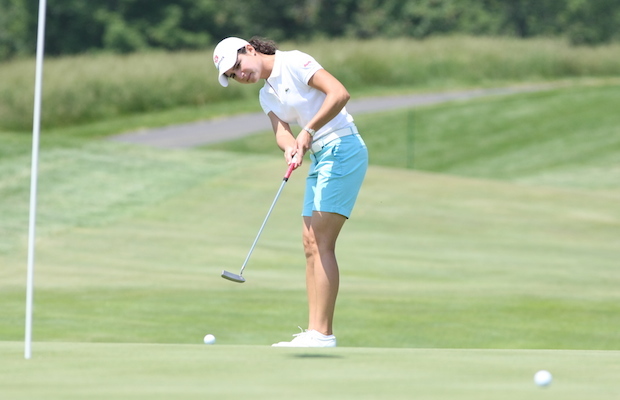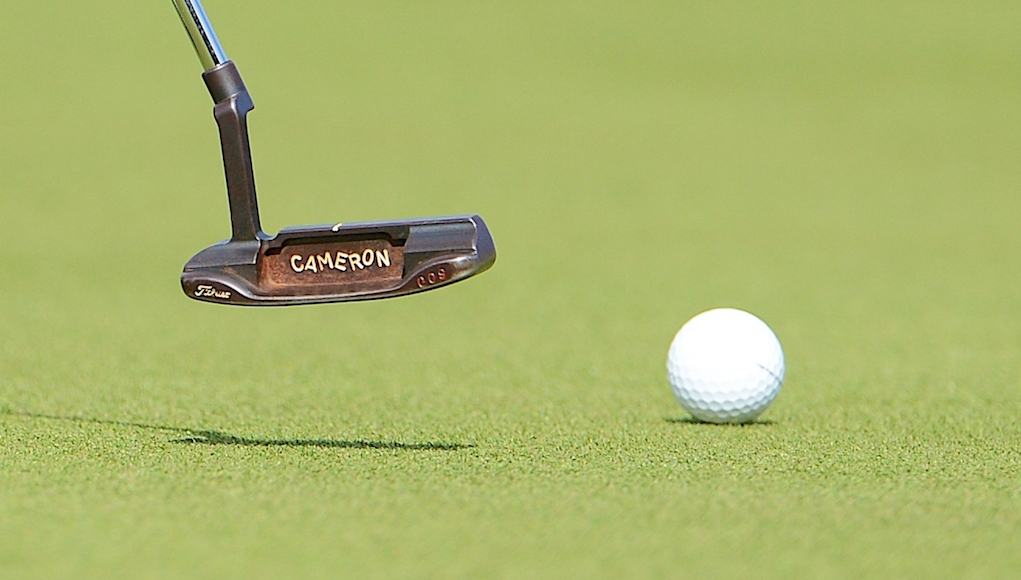Instruction
Teaching feel in putting

One of the most enigmatic portions of putting has been the relationship between line and speed. Golfers know that their lines are determined by the speed in which they hit a putt, but how do they know how hard to hit it?
What I’m after is the answer to the age-old question, “How do you teach feel?” Isn’t there a more scientific way than what instructors have taught in the past to audit feel and help people to become better at consistently hitting their putts the same distance?
In my putting academy, I use Advanced Motion Measurement’s 3D Motion Analysis System and the SAM Puttlab by Science & Motion Sports to teach “feel.” These two high-tech systems will be used to correlate the data contained below.
The SAM Analysis above shows the “time signatures” and “stroke lengths” of 10 putts in succession charting the backswing speed, forward swing speed, time to impact and overall putter head acceleration during the differing strokes. These “signatures” as compared to the overall “length” of the putting stroke help us see the consistency of one’s stroke dynamics and discover whether or not “feel” can be taught or not.
- The top-left time graph (in image 2 below) pertains to putter head speed on the way back. It shows just how fast the putter is moving in milliseconds. The Tour average is around 650 ms.
- The top-right time graph shows the speed of the putter into the forward swing, through impact and into the finish. The Tour average is around 300 ms.
- The bottom-left time graph is the acceleration of the putter from address to the top of the backstroke. A flat line shows that acceleration is constant, thus the speed of the putter head at this point is neither accelerating nor decelerating.
- The bottom-right time graph shows the transitional acceleration of the putter into the forward swing and on to the finish. The steeper the line moves up, the more putter acceleration there is and the faster the putter is moving in milliseconds. If the line descends, then the putter acceleration is slowing and its speed is diminishing.
Image 2
The movement dynamics of the above player’s motion shows a wonderful timing signature as all of the lines on the four graphs are not jagged during the backswing and/or forward swing. This shows consistency within this player’s putter head speed and putter head acceleration back and through.
In viewing the putter path length graph, this professional player was asked to hit the same 15-foot putt over and over while this data was taken. Subsequently, the backswing length and forward swing length are symmetrical indicating consistency within the length of stroke. When you take a couple controlled length strokes with the same type of “timing signature” for each putt, you will find the ball wanting to move the same distance unless an outside force acts upon it, changing its roll. Think of wind, dead spots on the green, etc.
One note regarding your “stroke length” and “timing signatures:” It is very easy to repeat a stroke that is consistent in length, acceleration and timing if and only if your impact alignments are sound and solid. We never want a golfer’s wrists to take over and power the stroke. In a perfect world, we only want them to react to the motions of your shoulders and arms.
The 3D analysis of the professional used in the “correct” putting sample graphs above shows that at impact the forward wrist and rear wrists are in solid alignments as the shaft is leaning 0.1 degrees forward. This is the most consistent impact position that you can have. Whenever the forward wrist “breaks down” and the club shaft leans back through impact, a golfer has added loft to the putter face. That makes “feel” almost impossible to have when a golfer needs it.
As you compare the speed and acceleration graphs between the professional player in image 2 and the mid-handicap amateur below in image 5, you will notice a huge difference between the consistency of the “signatures,” as well as poor control of the putting stroke length back and through.
Image 5
Examining the four graphs in image 5 helps us to see that each of these strokes had a very different “timing signature” and logically, if you cannot move the putter back and through the same speed on the same length putt you are going to have problems with pace.
Not only does this player have trouble controlling the speed and acceleration of his putter, but he also has issues controlling the length of his stroke back and through. Remember that this mid-handicap player was asked to hit the SAME length putt over and over (15 feet) and this lack of consistently shows that his player cannot control his speed/acceleration or his backstroke/follow-through swing length. This makes it very hard for this player to develop a consistent “feel” on the greens because nothing is constant from putt to putt and stroke to stroke.
Now the point must be made: Did this player have trouble with his speed because his swing length was off or was he having trouble with his swing length because his speed was off? I believe that it can happen either way! Someone who takes the putter back “super slow” will often adjust and move through impact much faster, however, the opposite argument can be made that when this player takes the club back too long or too short. His subconscious takes over and adjusts his swing forward swing length to accommodate. When this reaction occurs, a golfer’s timing signatures will become grossly inconsistent.
The Mechanical Conclusion: My 3D analysis and the SAM data prove that in order to have “feel” on the greens, golfers must do several things in order to reproduce the same stroke:
- They must control the overall length of their backstroke and follow-through on putts with the same general length.
- They must control not only the overall speed of their overall stroke, but its acceleration as well; thus, all the lines on each graphs will almost appear as “one.”
- For “swing” putters like Ben Crenshaw, they must accelerate into the impact zone, maintaining a constant velocity through impact in order to control the ball’s reaction. This is shown on the bottom right graph by the “table-top” looking acceleration curve. Impact occurs at the point where the “table-top” falls off on the right side. This is the acceleration signature of a player who plays on fast greens.
- As a “hit” putter like Nick Price, golfers must accelerate in the beginning of the backstroke and into to the ball with a “popping” type of action. This is shown on the bottom right graph as acceleration begins. It table-tops just before impact and then accelerates once again into the ball (shown by the steep peak) and then drops off rapidly. The second acceleration is the “pop” through impact seen by Price and is usually a mark of someone who has grown up on slower greens.
- During the forward swing and into and through impact, a golfer’s wrists should remain as solid as possible allowing the club shaft to return to the golf ball in a position that will allow it to propel the ball as consistently as possible.
Can we teach really teach any type of “feel” to the sample player who had poor length control and poor timing to his speed and acceleration signatures? The answer is YES, and here is how I did it for one of my students.
The “Feel” Procedure
First, instructors must help this player to understand why he has no feel and why he cannot control his pace on the greens. This was accomplished by showing him his stroke length graph as well as his stroke timing graphs. He was told to keep the thoughts simple and just to understand that his backstroke length varied widely and he could not control the timing of his stroke. Whether this was mainly due to his backstroke length or his backstroke speed was not of interest.
Second, in a logical format, he was given biofeedback with the SAM unit so that he could actually monitor the length of his backswing on the sample 15-foot putt.
Third, once he began to show some type of a consistent feel to the length of this putt, it was time to introduce another thought.
Fourth, he was told to make the same length of stroke but to find a “natural” tempo for his backstroke to follow. My thinking was that if we could get him to make consistent length strokes at the same pace, the forward swing would take care of itself.
Fifth, after many rounds of testing this proved to be the key to him “improving or learning” feel. What was discovered was that if the stroke was allowed to lengthen then this player’s putter pace tried to make up for the faulty backswing through the ball causing poor timing signatures.
Note: In further testing, some players had the opposite problem and had to control the speed of the backstroke for the putter length to become consistent. These people were the exception, however, and not the norm. It seemed that it was much easier for players to control their length first and then control the speed of this new stroke on the way back. After one week of SAM training with the biofeedback, it was decided that this was the proper training protocol for this player.
In conclusion, if you have trouble with your feel, you must monitor your stroke length and pace while maintaining proper impact alignments. When most people “lose their feel” the length of the stroke becomes inconsistent for the putt at hand and the backstroke speed and acceleration suffer as a result. The only thing for your body to do is to try and amend the flaw on the way through by changing their forward swing length, speed and acceleration.
Instruction
The Wedge Guy: Beating the yips into submission

There may be no more painful affliction in golf than the “yips” – those uncontrollable and maddening little nervous twitches that prevent you from making a decent stroke on short putts. If you’ve never had them, consider yourself very fortunate (or possibly just very young). But I can assure you that when your most treacherous and feared golf shot is not the 195 yard approach over water with a quartering headwind…not the extra tight fairway with water left and sand right…not the soft bunker shot to a downhill pin with water on the other side…No, when your most feared shot is the remaining 2- 4-foot putt after hitting a great approach, recovery or lag putt, it makes the game almost painful.
And I’ve been fighting the yips (again) for a while now. It’s a recurring nightmare that has haunted me most of my adult life. I even had the yips when I was in my 20s, but I’ve beat them into submission off and on most of my adult life. But just recently, that nasty virus came to life once again. My lag putting has been very good, but when I get over one of those “you should make this” length putts, the entire nervous system seems to go haywire. I make great practice strokes, and then the most pitiful short-stroke or jab at the ball you can imagine. Sheesh.
But I’m a traditionalist, and do not look toward the long putter, belly putter, cross-hand, claw or other variation as the solution. My approach is to beat those damn yips into submission some other way. Here’s what I’m doing that is working pretty well, and I offer it to all of you who might have a similar affliction on the greens.
When you are over a short putt, forget the practice strokes…you want your natural eye-hand coordination to be unhindered by mechanics. Address your putt and take a good look at the hole, and back to the putter to ensure good alignment. Lighten your right hand grip on the putter and make sure that only the fingertips are in contact with the grip, to prevent you from getting to tight.
Then, take a long, long look at the hole to fill your entire mind and senses with the target. When you bring your head/eyes back to the ball, try to make a smooth, immediate move right into your backstroke — not even a second pause — and then let your hands and putter track right back together right back to where you were looking — the HOLE! Seeing the putter make contact with the ball, preferably even the forward edge of the ball – the side near the hole.
For me, this is working, but I am asking all of you to chime in with your own “home remedies” for the most aggravating and senseless of all golf maladies. It never hurts to have more to fall back on!
Instruction
Looking for a good golf instructor? Use this checklist

Over the last couple of decades, golf has become much more science-based. We measure swing speed, smash factor, angle of attack, strokes gained, and many other metrics that can really help golfers improve. But I often wonder if the advancement of golf’s “hard” sciences comes at the expense of the “soft” sciences.
Take, for example, golf instruction. Good golf instruction requires understanding swing mechanics and ball flight. But let’s take that as a given for PGA instructors. The other factors that make an instructor effective can be evaluated by social science, rather than launch monitors.
If you are a recreational golfer looking for a golf instructor, here are my top three points to consider.
1. Cultural mindset
What is “cultural mindset? To social scientists, it means whether a culture of genius or a culture of learning exists. In a golf instruction context, that may mean whether the teacher communicates a message that golf ability is something innate (you either have it or you don’t), or whether golf ability is something that can be learned. You want the latter!
It may sound obvious to suggest that you find a golf instructor who thinks you can improve, but my research suggests that it isn’t a given. In a large sample study of golf instructors, I found that when it came to recreational golfers, there was a wide range of belief systems. Some instructors strongly believed recreational golfers could improve through lessons. while others strongly believed they could not. And those beliefs manifested in the instructor’s feedback given to a student and the culture created for players.
2. Coping and self-modeling can beat role-modeling
Swing analysis technology is often preloaded with swings of PGA and LPGA Tour players. The swings of elite players are intended to be used for comparative purposes with golfers taking lessons. What social science tells us is that for novice and non-expert golfers, comparing swings to tour professionals can have the opposite effect of that intended. If you fit into the novice or non-expert category of golfer, you will learn more and be more motivated to change if you see yourself making a ‘better’ swing (self-modeling) or seeing your swing compared to a similar other (a coping model). Stay away from instructors who want to compare your swing with that of a tour player.
3. Learning theory basics
It is not a sexy selling point, but learning is a process, and that process is incremental – particularly for recreational adult players. Social science helps us understand this element of golf instruction. A good instructor will take learning slowly. He or she will give you just about enough information that challenges you, but is still manageable. The artful instructor will take time to decide what that one or two learning points are before jumping in to make full-scale swing changes. If the instructor moves too fast, you will probably leave the lesson with an arm’s length of swing thoughts and not really know which to focus on.
As an instructor, I develop a priority list of changes I want to make in a player’s technique. We then patiently and gradually work through that list. Beware of instructors who give you more than you can chew.
So if you are in the market for golf instruction, I encourage you to look beyond the X’s and O’s to find the right match!
Instruction
What Lottie Woad’s stunning debut win teaches every golfer

Most pros take months, even years, to win their first tournament. Lottie Woad needed exactly four days.
The 21-year-old from Surrey shot 21-under 267 at Dundonald Links to win the ISPS Handa Women’s Scottish Open by three shots — in her very first event as a professional. She’s only the third player in LPGA history to accomplish this feat, joining Rose Zhang (2023) and Beverly Hanson (1951).
But here’s what caught my attention as a coach: Woad didn’t win through miraculous putting or bombing 300-yard drives. She won through relentless precision and unshakeable composure. After watching her performance unfold, I’m convinced every golfer — from weekend warriors to scratch players — can steal pages from her playbook.
Precision Beats Power (And It’s Not Even Close)
Forget the driving contests. Woad proved that finding greens matters more than finding distance.
What Woad did:
• Hit it straight, hit it solid, give yourself chances
• Aimed for the fat parts of greens instead of chasing pins
• Let her putting do the talking after hitting safe targets
• As she said, “Everyone was chasing me today, and managed to maintain the lead and played really nicely down the stretch and hit a lot of good shots”
Why most golfers mess this up:
• They see a pin tucked behind a bunker and grab one more club to “go right at it”
• Distance becomes more important than accuracy
• They try to be heroic instead of smart
ACTION ITEM: For your next 10 rounds, aim for the center of every green regardless of pin position. Track your greens in regulation and watch your scores drop before your swing changes.
The Putter That Stayed Cool Under Fire
Woad started the final round two shots clear and immediately applied pressure with birdies at the 2nd and 3rd holes. When South Korea’s Hyo Joo Kim mounted a charge and reached 20-under with a birdie at the 14th, Woad didn’t panic.
How she responded to pressure:
• Fired back with consecutive birdies at the 13th and 14th
• Watched Kim stumble with back-to-back bogeys
• Capped it with her fifth birdie of the day at the par-5 18th
• Stayed patient when others pressed, pressed when others cracked
What amateurs do wrong:
• Get conservative when they should be aggressive
• Try to force magic when steady play would win
• Panic when someone else makes a move
ACTION ITEM: Practice your 3-6 foot putts for 15 minutes after every range session. Woad’s putting wasn’t spectacular—it was reliable. Make the putts you should make.
Course Management 101: Play Your Game, Not the Course’s Game
Woad admitted she couldn’t see many scoreboards during the final round, but it didn’t matter. She stuck to her game plan regardless of what others were doing.
Her mental approach:
• Focused on her process, not the competition
• Drew on past pressure situations (Augusta National Women’s Amateur win)
• As she said, “That was the biggest tournament I played in at the time and was kind of my big win. So definitely felt the pressure of it more there, and I felt like all those experiences helped me with this”
Her physical execution:
• 270-yard drives (nothing flashy)
• Methodical iron play
• Steady putting
• Everything effective, nothing spectacular
ACTION ITEM: Create a yardage book for your home course. Know your distances to every pin, every hazard, every landing area. Stick to your plan no matter what your playing partners are doing.
Mental Toughness Isn’t Born, It’s Built
The most impressive part of Woad’s win? She genuinely didn’t expect it: “I definitely wasn’t expecting to win my first event as a pro, but I knew I was playing well, and I was hoping to contend.”
Her winning mindset:
• Didn’t put winning pressure on herself
• Focused on playing well and contending
• Made winning a byproduct of a good process
• Built confidence through recent experiences:
- Won the Women’s Irish Open as an amateur
- Missed a playoff by one shot at the Evian Championship
- Each experience prepared her for the next
What this means for you:
• Stop trying to shoot career rounds every time you tee up
• Focus on executing your pre-shot routine
• Commit to every shot
• Stay present in the moment
ACTION ITEM: Before each round, set process goals instead of score goals. Example: “I will take three practice swings before every shot” or “I will pick a specific target for every shot.” Let your score be the result, not the focus.
The Real Lesson
Woad collected $300,000 for her first professional victory, but the real prize was proving that fundamentals still work at golf’s highest level. She didn’t reinvent the game — she simply executed the basics better than everyone else that week.
The fundamentals that won:
• Hit more fairways
• Find more greens
• Make the putts you should make
• Stay patient under pressure
That’s something every golfer can do, regardless of handicap. Lottie Woad just showed us it’s still the winning formula.
FINAL ACTION ITEM: Pick one of the four action items above and commit to it for the next month. Master one fundamental before moving to the next. That’s how champions are built.
PGA Professional Brendon Elliott is an award-winning coach and golf writer. You can check out his writing work and learn more about him by visiting BEAGOLFER.golf and OneMoreRollGolf.com. Also, check out “The Starter” on RG.org each Monday.
Editor’s note: Brendon shares his nearly 30 years of experience in the game with GolfWRX readers through his ongoing tip series. He looks forward to providing valuable insights and advice to help golfers improve their game. Stay tuned for more Tips!
































Selim
Feb 25, 2014 at 2:22 pm
Frankly, I could not read on after the first explanation of 4 graphs. Maybe it is because I am an engineer bit blatant disregard (or misrepresentation) of physics is annoying to say the least.
First graph: “tour speed is 650 ms”, is like saying a car travels 650 per hour. What is the distance that it travels in 650 milliseconds? That would be its speed (Speed = distance/time)
Second Graph: Same mistake, you are giving a measurement of time, not speed when you say 300ms.
Third graph: you say acceleration is constant meaning no acceleration or deceleration. Actually, the speed is constant only if acceleration is zero. In other times it means the speed is increasing or decreasing.
Maybe you think I am nitpicking but I can’t read a technical analysis if it is technically wrong.
Mark
Mar 1, 2014 at 3:53 pm
I agree. As an ME, I can’t help but notice the poor display of technical communication. I’m not saying that this whole article is wrong, but it definitely discredits the point when your analysis is not done correctly.
jeff
Feb 24, 2014 at 8:58 pm
Excellent
paul
Feb 24, 2014 at 8:37 pm
I love these very technical articles. I learned distance control with a putter on a simulator… If that’s not weird I don’t know what is. I spent an hour one day hitting putts to a virtual hole 15 feet away. And remembered the feel. Then did 45 foot putts for a while. If I know approximately how far away the hole is I just try and feel that distance in my head. Then putt. Seems to work. Played 18 holes by Vancouver a few weeks ago and distance control was never so good. (for uphill and downhill, think about feeling a few feet more or less)
Tom Stickney
Feb 25, 2014 at 9:27 am
Appreciate the comments. 🙂